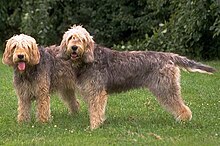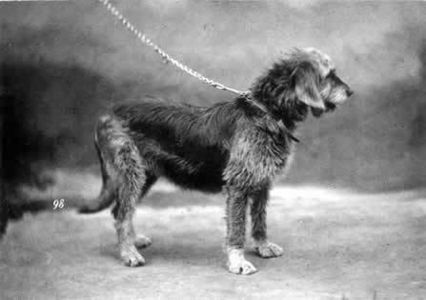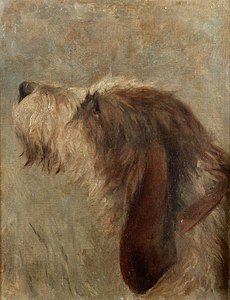This is an old revision of this page, as edited by PrimeBOT (talk | contribs) at 04:18, 19 October 2024 (→External links: Task 24: elink template removal following a TFD). The present address (URL) is a permanent link to this revision, which may differ significantly from the current revision.
Revision as of 04:18, 19 October 2024 by PrimeBOT (talk | contribs) (→External links: Task 24: elink template removal following a TFD)(diff) ← Previous revision | Latest revision (diff) | Newer revision → (diff) Dog breed| Otterhound | |||||||||||||||||||||||||
|---|---|---|---|---|---|---|---|---|---|---|---|---|---|---|---|---|---|---|---|---|---|---|---|---|---|
 Otterhounds Otterhounds | |||||||||||||||||||||||||
| Origin | England | ||||||||||||||||||||||||
| |||||||||||||||||||||||||
| |||||||||||||||||||||||||
| Dog (domestic dog) | |||||||||||||||||||||||||
The Otterhound is an English dog breed. It is a scent hound and is currently recognised by the Kennel Club as a Vulnerable Native Breed with around 600 animals worldwide.
Ancestry
The first recorded Otterhounds known to resemble the current breed are in the North-West of England in the first half of the 19th century – for example, the Hawkstone Otter Hunt and Squire Lomax's Otterhounds. In the second half of the 19th century, French Griffons were outcrossed, including one-eighth Wolf cross/Griffon Vendéen from the Comte de Canteleu in Normandy. In the early 20th century the Griffon Nivernais was crossed into the breed, and one particular dog, Boatman, a Grand Griffon Vendéen/Bloodhound cross, became an ancestor for several kennels.
Appearance
The Otterhound is a large, rough coated, and straight limbed dog. The head is deep but not wide with the rough coat giving it a beard or moustache of sorts. The nose is wide. The eyes are deep set with the haw only slightly showing. The ears are long and pendulous, they roll inwards as to create a 'drape' appearance. The neck is long a slight dewlap is allowed. The forelegs are straight from the elbow to the ground. Pasterns are slightly strung. Hind legs are well-muscled with heavily muscled thighs, in a normal stance the hind legs from hock to ground are perpendicular. Feet are large, round, and thick padded. The tail is thick at the base and never curls over the back. The coat is 4–8 cm (1.6–3.1 in) in length, dense, rough, and waterproof; appears broken. Height at the shoulder is 69 cm (27 in) for dogs and 61 cm (24 in) for bitches. Otterhounds generally weigh between 80 and 115 pounds (36 and 52 kg).
Coat colours
Recognised colours are: whole coloured, grizzle, sandy, red, wheaten, and blue; with white markings permissible in all of them as well as lemon, blue, or badger pied markings.
Hunting

Otter hunting dates back to the early medieval period, with references to it found as early as 1360. The Otterhound, however, can only be traced back as a distinct breed as far as the early 1800s. To be equal to the otter, an Otterhound was said to need "a Bulldog's courage, a Newfoundland's strength in water, a Pointer's nose, a Retriever's sagacity, the stamina of a Foxhound, the patience of a Beagle, and the intelligence of a Collie."
In 1978, due to the dramatic decline in otter numbers, the otter was placed on the list of protected species in Britain, and otter hunting therefore ceased. It was never banned in Britain, the otter hunts stopped hunting voluntarily, as it was they who realised that otter numbers were dropping dramatically and brought it to the attention of the authorities. By 1977, nine registered packs of otterhounds were still in existence. A few hunts switched to hunting mink or coypu, but many of the original otterhound packs ceased to exist altogether. Hounds were often passed to newly founded minkhound packs. The Pembroke and Carmarthenshire Minkhounds are the only pack today with a pure otterhound pack. As the dogs had been selectively bred for their hunting capabilities, only a few of the bloodlines were suitable for breeding into companion animals.
Health
A survey of breed club members in the UK found a life expectancy of 10.21 years. The same survey identified a predisposition to gastric dilatation volvulus with 9% of Otterhounds having the condition and 7.4% of deaths attributable to the condition.
Endangered breed
In 2012 it was estimated there were around 600 otterhounds in the world. It is considered to be the most endangered native breed in Britain, with only 41 new registrations in 2016. This is partly because otterhounds have never been numerous, and even in the early 20th century, when otter hunting as a sport was at the height of its popularity, the number of dogs was still small. They are on the list of Vulnerable Native Breeds as identified by the UK Kennel Club, and great efforts are being made to save the breed.
-
An Otterhound, published in 1859
-
 Otterhound 1879
Otterhound 1879
-
 Otterhound by Frances C. Fairman, circa 1900
Otterhound by Frances C. Fairman, circa 1900
See also
References
- ^ "UK native dog breeds 'at risk of extinction', BBC News
- "English Otterhound". Otterhound. Retrieved 23 September 2018.
- Adair, Rod J. A CHAIN OF BUBBLES... OTTER HUNTS 1157–1977 & MINK HUNTS 1977-1998.
- Lee, Rawdon B, 1893, History and Description of the Modern Dogs of Great Britain and Ireland, Sporting Division
- ^ Cunliffe, J, 2003, Otterhound: Special Rare Breed Edition, Kennel Club Books
- ^ "Otterhound Standard". The Kennel Club. Retrieved 20 February 2024.
- "Otterhound". AKC. Archived from the original on 23 December 2014. Retrieved 23 December 2014.
- Leighton, R, 1910, Dogs and All About Them, Cassel and Company Ltd, London
- Adams, V. J.; Evans, K. M.; Sampson, J.; Wood, J. L. N. (2010-10-01). "Methods and mortality results of a health survey of purebred dogs in the UK". Journal of Small Animal Practice. 51 (10): 512–524. doi:10.1111/j.1748-5827.2010.00974.x. PMID 21029096.
- Evans, Katy M.; Adams, Vicki J. (2010). "Mortality and morbidity due to gastric dilatation-volvulus syndrome in pedigree dogs in the UK". Journal of Small Animal Practice. 51 (7): 376–381. doi:10.1111/j.1748-5827.2010.00949.x. ISSN 0022-4510. PMID 20626784.
- "The puppies rarer than giant pandas", The Daily Telegraph, 5 March 2007, page 9
Bibliography
- Leighton, Robert (2004). Dogs and All About Them. Kessinger Publishing. ISBN 1419116363.
- Cunliffe, Juliet (2003). Otterhound: Rare Breed Special Editions. Kennel Club Books. ISBN 1-84286-058-5.
External links
![]() Media related to Otterhound at Wikimedia Commons
Media related to Otterhound at Wikimedia Commons